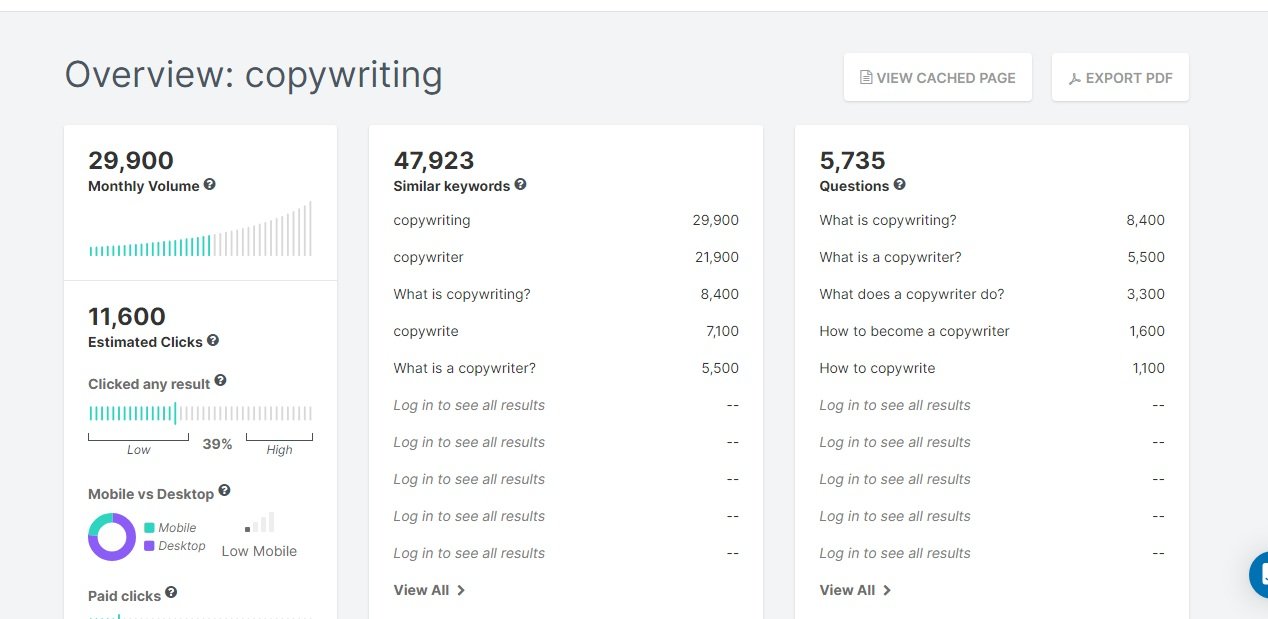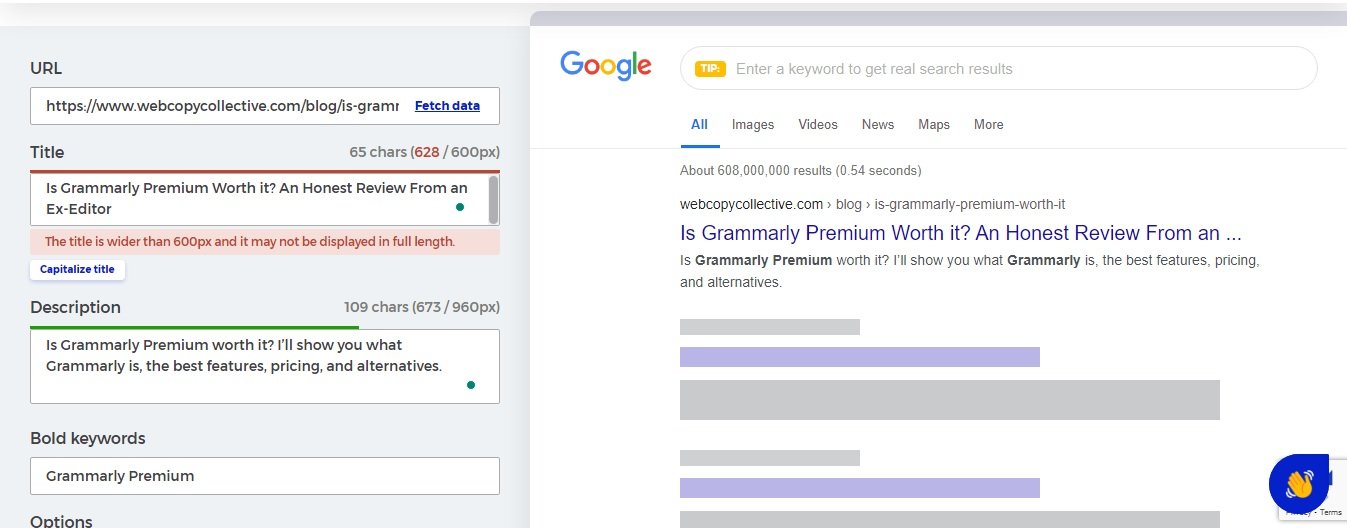9 Best Copywriting Tools for Content Creation
Coming up with great content for your business website doesn’t have to be difficult. There are some great free copywriting tools out there to help you with keyword research, headline writing, spell check, and much more.
In this guide, I’ll show you ten of my favorite copywriting tools that I regularly use to write blog content. Whether you use the paid or free versions, they will make your life much easier when it comes to content creation.
Speaking of copywriting software… Want to know whether you should use AI for content generation?
9 Best Copywriting Tools for Content Creation
I’ve only included copywriting tools that are totally free, have a free version, or come with a free trial.
Don’t invest money in any tool unless you can test it out and figure out if it’s right for your business.
1) Grammarly Premium
This is easily my most-used copywriting tool. I use Grammarly every single day for blogging, emails, client work, and more.
This AI writing tool automatically checks your spelling, grammar, writing style, and wording choice and gives you suggestions for improvement.
It also has a plagiarism checker to ensure your content is unique, which is a must-have if you’re doing research for your post.
You can get started with Grammarly for free, and the Chrome extension means it will work in Google Drive, your browser, and your email. This is great for catching errors in your business writing. However, the premium version offers a lot more features.
Related: Is Grammarly Premium worth it? Read my full review to find out!
2) SpyFu
If you’re totally stuck on what to blog about, SpyFu is a great AI copywriting tool. Type in the domain name of a competitor, and it will show you the top-performing content on their website. You’ll also get a full history of Google ads they’ve run, which will have useful keyword information.
Now, I’m not telling you to use this tool to rip off your competition. But when you’re stuck for content ideas, it’s good to know what’s already working well in your industry.
When you’ve found ideas, commit to creating more valuable, in-depth articles that have a chance of outranking your competition in organic searches.
You can get started with the SpyFu copywriting software for $9 a month, with a 30-day money-back guarantee. This gets you 10,000 domain results for “small” domains (less than 1000 keywords). If you’re just starting out, this should be plenty.
Related: My Top 7 Keyword Research Tools to Boost Website Traffic
3) Sharethrough Headline Analyzer
Your blog headline should instantly interest readers and encourage them to click. If it’s bland, uninteresting, or simply not quite engaging enough, you’re missing out on traffic.
That’s where my favourite headline analyzer comes in. Sharethrough is a free title analyzer that quickly gives you a quality score based on over 300 variables.
Once it’s generated a score, it gives you some tips for improvements, including wording choice, context, and what to take out.
If I’m ever feeling writer’s block and can’t quite come up with a good title for a blog, I see what Sharethrough has to say.
Warning: Don’t go crazy trying to over-optimize your headlines to get a super high score – this free copywriting tool should simply help you get better at crafting engaging headlines.
4) Answer The Public
My next must-have copywriting tool is Answer The Public. This web-based tool helps you find frequently asked questions surrounding a specific keyword, along with search volumes, ad spends, and ranking difficulty.
The visual wheels show you which questions are most frequently asked and give you some great ideas for blog writing.
Not all of the questions will be relevant, so use your best judgement to pick out ones that work for your blog.
When you sign up for free, you get three free searches a day – so use them wisely. For more searches and richer data on keywords, you’ll need to sign up for a paid plan.
You get a 7-day free trial to see if you like the tool, and then individual plans start at £9 a month.
Yes, you can use Google Keyword Planner for free, but this saves hours of time researching keywords and gives you instant access to the perfect topics for your blog.
If you can write a blog post answering all the top questions in a wheel, you’ll easily start ranking on Google.
When you want some free inspiration for your next blog post, head to Copywriting Examples. It’s a huge repository of the world’s best online content.
It can feel a little overwhelming when you first search through the copywriting software, but it gives some great examples of conversion-focused copywriting.
Annoyingly, you can’t refine your search to specific keywords, but you can get ideas for how to write engaging, branded copy for your website.
I don’t really use this one for specific keyword research, but I do like to take inspo from layouts and graphic design. Take a look at what grabs your attention and figure out how you can use the same principles for your blog.
Related: How to Write Drool-Worthy Website Copy That Converts
5) ChatGBT
I’m not a fan of AI-generated content, and I truly believe blogs written by humans get much better results. But you can use AI to make content creation quicker and easier.
ChatGBT is an AI copywriting tool that answers questions for you to save time scrolling through Google.
Ask it to come up with blog post titles on a certain topic, and it will give you answers through a chat interface. It even provides its sources, which can be great for research and competitor analysis.
The more specific your questions, the better its answers. For example, instead of asking:
“What are 10 blog post titles about copywriting?”
I could ask:
“I’m a content strategist who helps small business owners create more engaging website content. Give me 10 high-converting blog title ideas about copywriting that will help my ideal clients.”
Remember, whatever you ask it to generate, edit, and tweak the content to make it your own.
6) Mangools
Your blog posts need to be optimized for Google searches to help you rank better. One key element is planning how your blog will appear in search results, including the headline and excerpt.
If you use Squarespace like I do, you can customize the title and snippet for searches, but it’s always useful to check how this will show up for users.
Mangools Google SERP simulator shows you exactly how your blog will appear in searches. You can check whether your title gets cut off, your keyword rankings, potential paid searches, and more.
Use this AI copywriting tool to test out title and excerpt ideas, and when you’re happy, you can copy and paste them back into your blog builder – it’s quick and easy but makes a huge difference.
Related: How to Create a Website Content Planning Strategy You’ll Stick To
7) Canva
If you struggle to create eye-catching, branded graphics for your website, Canva is your new best friend. It has a huge database of templates that can be customized with your brand colours, fonts, logo, and more.
I use the paid version, but the free version of Canva has plenty of free illustrations, stock images, and fonts you can use to spruce up your blog post without paying a penny.
Almost all the graphics I use on my blog come from Canva, and I love how easy it is to create templates and then quickly customize them for each post.
8) Detailed
Detailed is a free SEO extension that gives you insights into any page on the internet. You’ll get information on blog word count, sub-heading, link count, and more.
I like to use this tool to spy on my competition and figure out how to create better content than the top-ranking post on Google. Here’s how:
Type your keyword into Google
Click on the #1 organic search link
Click the Detailed Chrome extension
Make a note of the word count and sub-heading structure.
Do a Ctrl+F and search for your keyword to see how many times they use it on the page.
Now, create a new piece of content that’s longer, more in-depth, and with a higher keyword density. Easy peasy!
Related: How to Write a Captivating About Page That Tells Your Brand Story
9) Google Trends
If you want to write about newsworthy or trending topics in your niche, Google Trends is another great AI copywriting tool. You can keep up to date with trending and viral topics in your industry and tap into content that will have maximum impact.
Your blog should be full of long-form, evergreen content that never goes out of date. But writing about trending topics every so often is a great way to boost traffic and establish yourself as an industry leader.
Google Trends is free to use and helps you stay relevant and become a thought leader in your niche, so check it frequently!
What Copywriting Tools Do You Love?
After working as a copywriter for over seven years, I tried just about every content tool on the market. Most weren’t worth the hype, but the tools in this post are genuinely helpful and made a real difference to my content creation process.
Wondering if you should use AI for content generation? Read this cautionary guide before spamming your website with AI blogs!






































![Is Grammarly Premium Worth it? [Review]](https://images.squarespace-cdn.com/content/v1/5910c2bec534a5947d4d3130/1739293407789-O7U2NFYVOR0DR6H06Y3N/Delicate+Feminine+Interior+Designer+Featured+Products+Facebook+Post+%2826%29.png)







